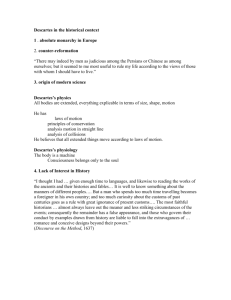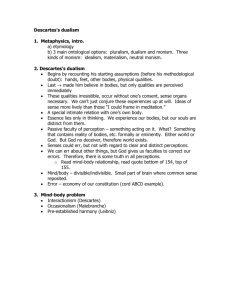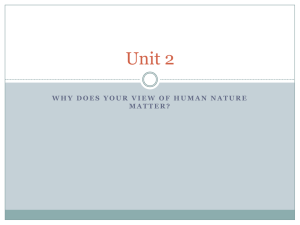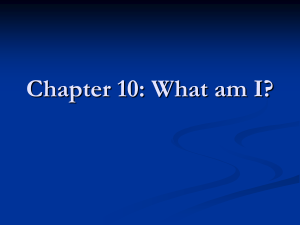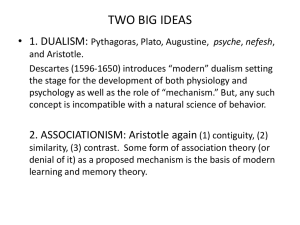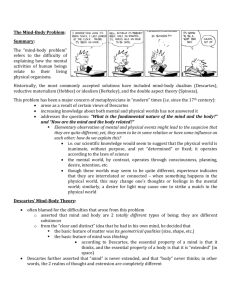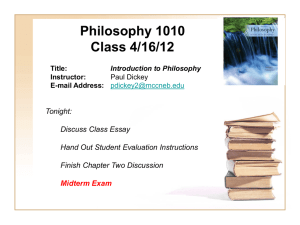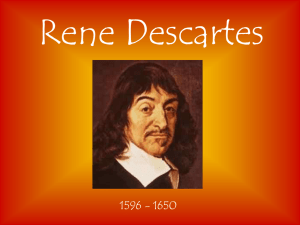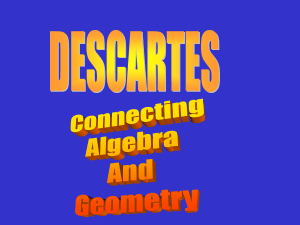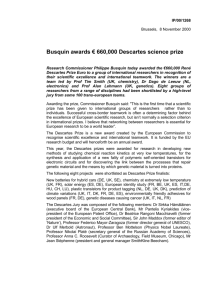Mind-Body Problem: Dualism vs. Materialism - Philosophy Notes
advertisement
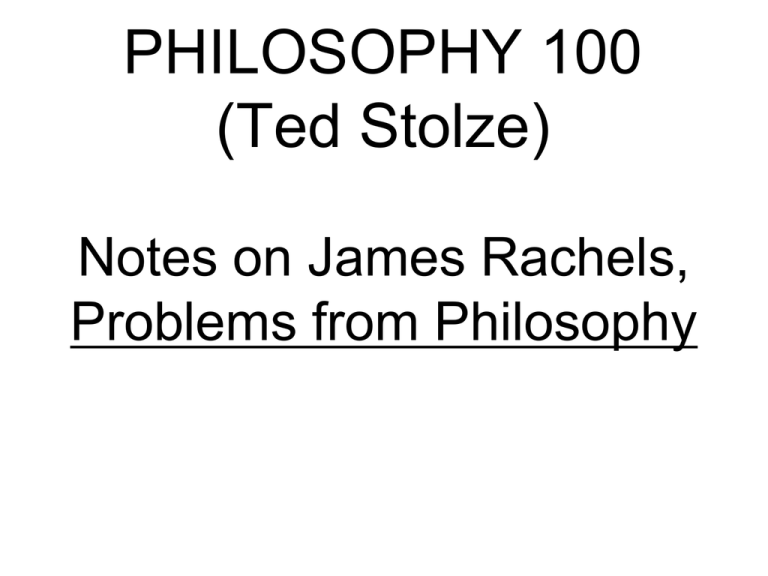
PHILOSOPHY 100 (Ted Stolze) Notes on James Rachels, Problems from Philosophy Chapter Six: Body and Mind Two Positions on the Mind/Body Problem • Dualism • Materialism René Descartes Descartes was an important 17th century thinker whose ideas have had a great influence down to the present day. He been called the “father of modern philosophy (and of mathematics). ” Perhaps his most famous philosophical work is called the Meditations on First Philosophy (1641). (1596-1650) Cartesian Dualism Body and mind are different substances, and mental states have the following two distinctive characteristics: (1) Privileged access (2) Infallibility Descartes on Minds and Machines “It is indeed conceivable that a machine could be made so that it could utter words, and even words appropriate to the presence of physical acts or objects which cause some change in its organs; as, for example, if it was touched in some spot that it would ask what you wanted to say to it; if in another, that it would cry that it was hurt, and so on for similar things. But it could never modify its phrases to reply to the sense of whatever was said in its presence as even the most stupid men do.” (From Discourse on Method, translated by Laurence J. Lafleur [Indianapolis, IN: Bobbs-Merrill, 1960 (1637)], pp. 41-42.) Princess Elizabeth of Bohemia’s Objection to Descartes How could a non physical mind interact with a physical body, and vice versa? (1618-1680) Descartes’s Responses to Elizabeth • • It’s too difficult to explain, so don’t worry about it! The pineal gland is where the mind interacts with the body: “The soul has its principal seat in the little gland in the middle of the brain, whence it radiates into all the rest of the body by the mediation of the spirits, nerves, and even blood, which, participating in the impressions of the spirits, can carry them through the arteries into all the members” (from The Passions of the Soul, 34, translated by Stephen H. Voss [Indianapolis, IN: Hackett, 1989], p. 37). NOTE: For Descartes the mind is connected to the entire body. Another Objection to Cartesian Dualism • The problem of the radical emergence of mind from matter during the evolution of life on earth (pp. 70-1) Three Kinds of Materialism • Behaviorism • Mind-Brain Identity • Functionalism Behaviorism Human thoughts and feelings can be explained purely in terms of observable behavior: “When someone shouts at us, we say it is because she is angry; when someone grabs a sandwich, we say it is because he is hungry” (p. 71). Support for Behaviorism Cross-cultural comparison of facial expression of emotions (see Paul Ekman, Emotions Revealed, revised edition [NY: Owl Books, 2007] and Daniel Goleman, Social Intelligence [NY: Bantam, 2006].) Consider the next two illustrations from Goleman’s book (pp. 39, 87). Identify the Emotion Expressed Below Objections to Behaviorism • The theory only makes sense of simple behaviors such as universal emotions--but how do you look when, for example, you are listening to a CD or watching a baseball game? • It is possible to control external behavior, for example, by presenting a “poker face.” • We need to distinguish between the external emotion and the internal feeling (see Antonio Damasio, Looking for Spinoza: Joy, Sorrow, and the Feeling Brain [NY: Harcourt Trade, 2003].) Mind-Brain Identity Mental events are neurological. “Each of a person’s mental states is identical with the firing of particular neurons, or cells, in the brain” (p. 75). Type/Token Distinction Ex: $20 is a type; the crumpled, old twenty dollar bill in my pocket and the crisp, new twenty dollar bill in your pocket are tokens of that type. Two Theses regarding Mind-Brain Identity Theory • Type-type identity = “being in pain (considered as a type of thing) is identical with a particular sort of neuron firing (considered as a type of thing)” (p. 76). • Token-token identity = “each instance of pain is identical with some particular physical state” (p. 76). Two Objections to Type-Type Identity (but not Token-Token Identity) • Pain comes in many forms • Life-form with a different physiology Functionalism “…[B]eing in pain is identical with the activation of a system that serves this function--that links these kinds of inputs, outputs, and relations to other internal states. For you, therefore, a particular token of pain may be a neural firing, while for an extraterrestrial a particular token of pain may be the activation of a different internal mechanism. The physical character of the mechanism doesn’t matter. All that matters is that the mechanism serves the appropriate function” (p. 78). Problems with Materialism • Can’t account well for subjectivity (thought experiment about the scientist Mary) • Can’t account well for intentionality • Can’t account well for mystical experiences • The mind is “wider” than the brain Other Examples of Intentionality • Love for a particular individual; and the associated problems of maternal separation and bereavement (see Bruce E. Wexler, Brain and Culture: Neurobiology, Ideology, and Social Change [Cambridge, MA: MIT Press, 2006]. • Hunger for actual food as opposed to the idea of food Steven Rose on “Having a Brain, Being a Mind” “. . . [B]rains are not merely in bodies. The individual organism, the person, is in the world. Brains and bodies are open, not closed systems, in continuous interaction with the external material, biological and social worlds. It is this which explains why . . . I want to argue that the mind is wider than the brain. . . . Thus, to say that brain enables consciousness is not to make a crude split between the neurological and the psychological, the biological and the social, or to separate, if that were possible, the phenomenon of consciousness from the content of consciousness. There can be no consciousness without content; indeed it is constituted by its content, and its content is not merely of the moment but of all past moments in he history of the individual. It is thus an emergent property, not to be dichotomised, indissolubly historically located. It exists in sets of relationships, between the person and the surrounding world, irreducible to mere neural mechanism but not a mysterious ghost in the machine either.” (Steven Rose, The Future of the Brain: The Promise and Perils of Tomorrow’s Neuroscience [NY: Oxford, 2005, pp. 165-167). [See also Lise Eliot, What’s Going on in There?: How the Brain and Mind Develop in the First Five Years of Life (NY: Bantam, 2000).] Brain, Organism, and World: Steven Rose’s Ecological Materialism
